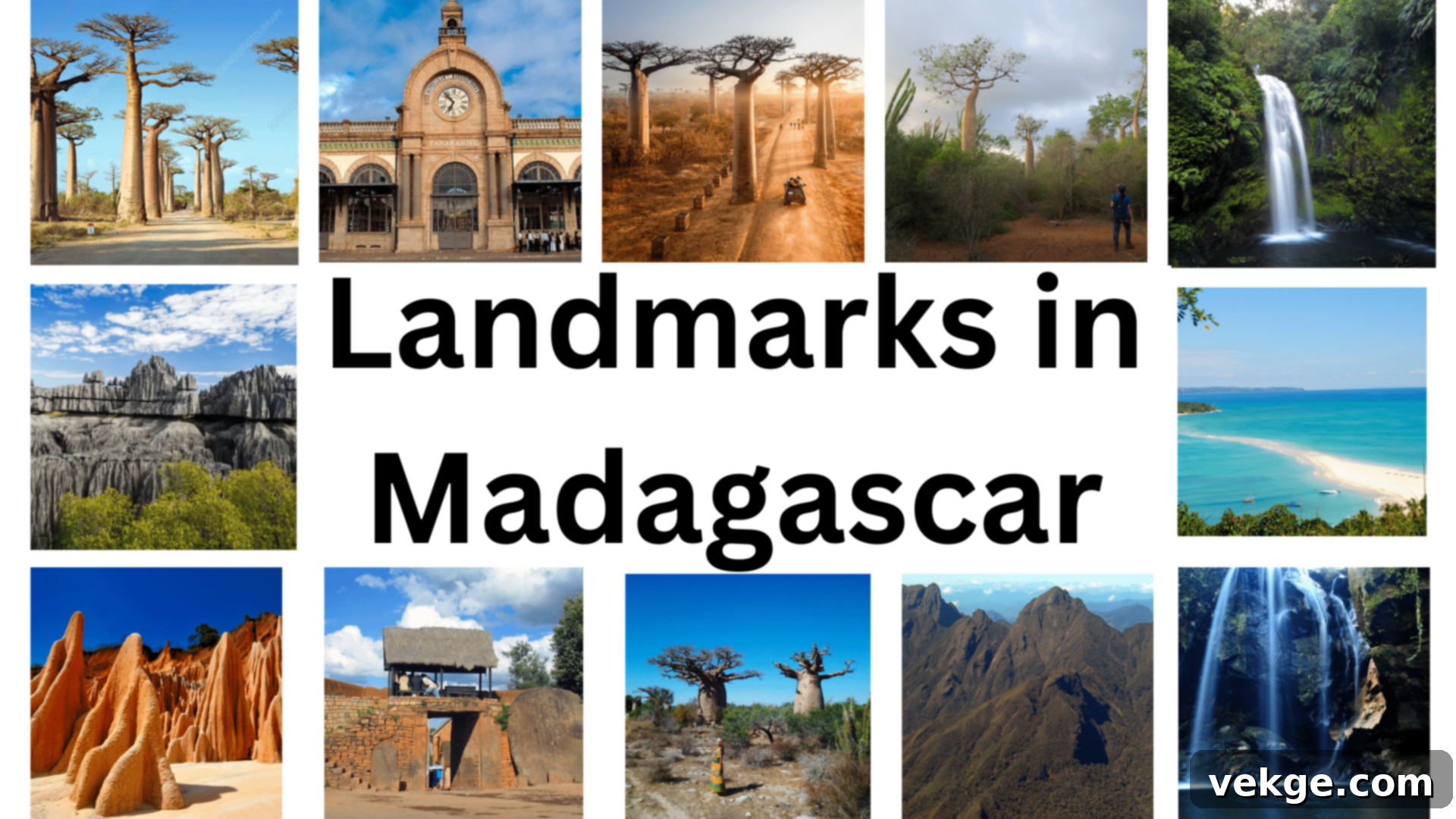Discover the Wonders of Madagascar: An Ultimate Guide to Its Iconic Landmarks and Natural Treasures
Madagascar, the world’s fourth-largest island, is a realm of unparalleled natural beauty and unique cultural heritage. Often described as a ‘world apart,’ this magnificent island nation boasts an extraordinary array of flora and fauna, 90% of which are found nowhere else on Earth. Its landscapes are a vibrant tapestry of towering baobab trees, jagged limestone forests, lush rainforests, pristine beaches, and bustling urban centers, each telling a story of millions of years of isolated evolution and rich human history. This comprehensive guide invites you on an unforgettable journey to explore the most amazing landmarks of Madagascar, from its iconic natural formations to its significant cultural sites.
Prepare to be captivated by Madagascar’s diverse natural wonders, which include some of the planet’s most remarkable sites. From the ancient, gnarled silhouettes of baobab trees silhouetted against fiery sunsets to the striking, almost alien formations of limestone ‘tsingy,’ Madagascar’s landmarks are a testament to its dramatic and untamed natural beauty. Beyond the breathtaking scenery, these sites offer a glimpse into the island’s vibrant culture and an exclusive chance to encounter its legendary wildlife, including numerous species of lemurs, chameleons, and exotic birds that have adapted to these unique environments. Whether you’re an avid adventurer, a devoted nature enthusiast, or a curious cultural explorer, Madagascar promises an experience unlike any other.
In this in-depth guide, we will delve into Madagascar’s most captivating landmarks, providing essential information, intriguing facts, and insider travel tips to help you plan your ultimate adventure. Get ready to uncover the secrets of this mesmerizing island and discover why its unique biodiversity and profound cultural heritage make it a truly exceptional destination on the global travel map. Join us as we explore the heart of this incredible island.
Why Madagascar’s Iconic Landmarks Are Essential to Explore
Madagascar’s landmarks are far more than just beautiful places to visit; they are living testaments to the island’s ancient geological past, its incredible biodiversity, and its rich cultural narrative. Each site offers a unique window into what makes Madagascar so special, reflecting centuries of isolation that have sculpted both its natural environment and the distinct traditions of its people. These significant locations serve as vital educational platforms, helping visitors understand the delicate ecosystems, the importance of conservation efforts, and the intricate balance of life on the island.
Many of these remarkable sites have earned global recognition for their outstanding universal value, receiving the prestigious designation of UNESCO World Heritage Sites. This international acknowledgment highlights their importance not only to Madagascar but to humanity as a whole, underscoring the urgent need to protect them for future generations. These landmarks help us connect with Madagascar’s fascinating history, its diverse cultural tapestry, and allow us to marvel at some of the most beautiful and scientifically significant sights on Earth. From ancient royal residences steeped in tradition to vast, untouched wildernesses teeming with life, they embody the unique spirit of Madagascar and inspire a deeper appreciation for our planet’s natural and cultural diversity.
Exploring these iconic locations offers an unparalleled opportunity to engage with local communities, support sustainable tourism practices, and witness firsthand the profound artistry of nature. They are crucial for ongoing scientific research, fostering ecological awareness among visitors, and providing sustainable economic opportunities for the local population. By embarking on a journey to these sites, you become an active participant in the global effort to preserve Madagascar’s irreplaceable legacy and contribute to its continued protection.
Iconic Natural Wonders and Cultural Treasures of Madagascar
1. Avenue of the Baobabs
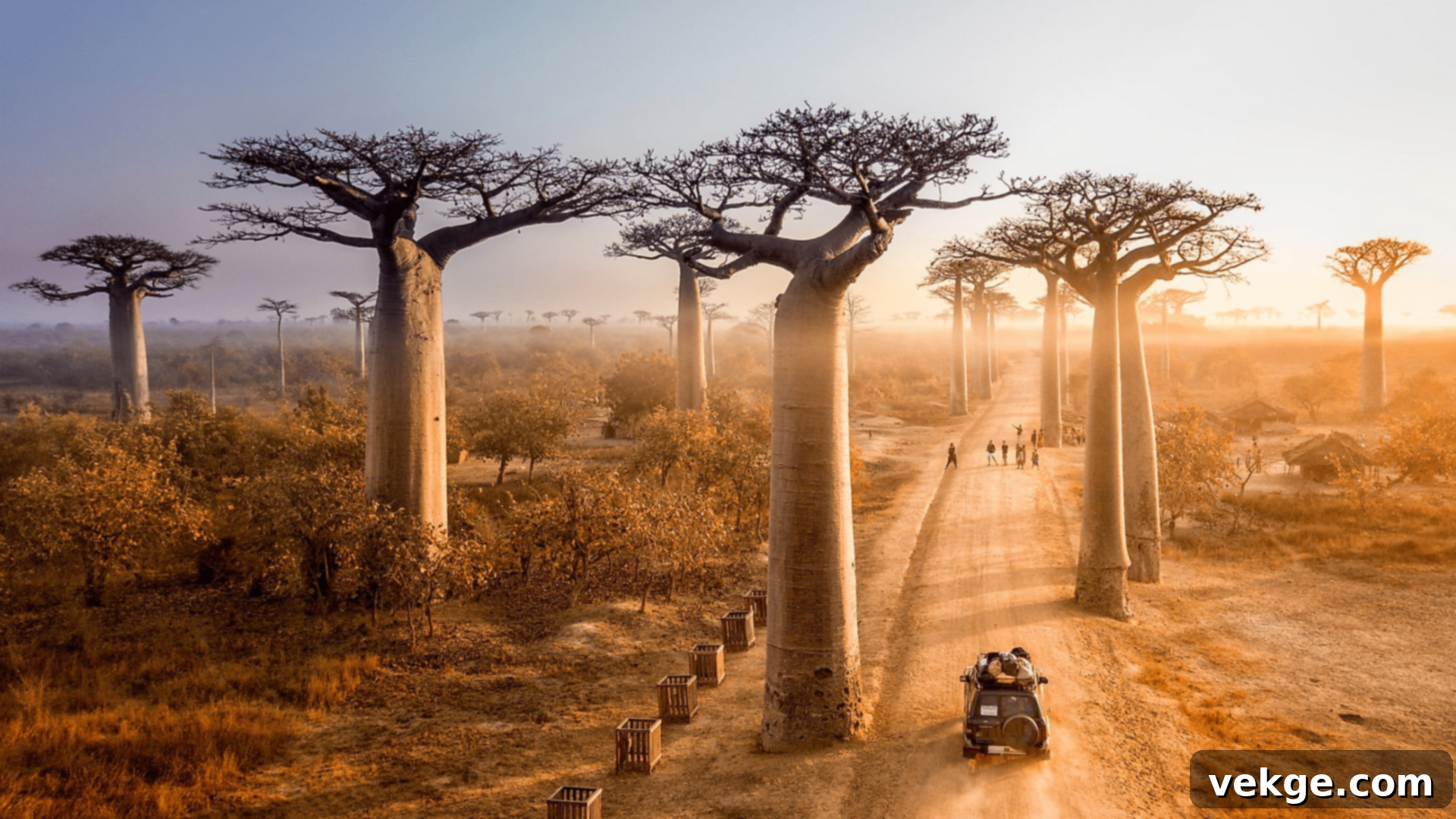
Overview: The Avenue of the Baobabs, or ‘Allée des Baobabs,’ is arguably one of Madagascar’s most iconic and frequently photographed landscapes. This striking dirt road, located in the Menabe region of western Madagascar, is flanked by two impressive rows of majestic baobab trees (Adansonia grandidieri). These towering, ancient giants create an ethereal natural avenue, especially captivating during the golden hours of sunrise and sunset. It’s a truly breathtaking spectacle that has come to symbolize the spirit of Madagascar’s unique natural heritage.
- Unique Experience: This natural marvel is best experienced at sunrise or sunset when the sky explodes with vibrant orange, pink, and purple hues, dramatically silhouetting the ancient trees and casting long, artistic shadows.
- Age and Resilience: Some of these magnificent baobab trees are estimated to be over 800 years old, having witnessed centuries of history and enduring the harsh Malagasy climate through their remarkable adaptations.
- Photographic Gem: Renowned as a premier photography spot, drawing professional photographers and tourists from across the globe eager to capture its unparalleled beauty and mystical atmosphere.
Why Visit: Standing amidst these colossal, age-old trees is a deeply moving and awe-inspiring experience that no photograph can truly convey. It’s a rare chance to connect with ancient nature, marvel at incredible botanical architecture, and witness a landscape found nowhere else on Earth. The sheer scale and enduring presence of these living monuments leave an indelible impression on every visitor.
Interesting Fact: Baobab trees are often referred to as the “upside-down trees” due to their unique appearance, where their branches resemble roots reaching towards the sky, an intriguing characteristic that has inspired many local legends and myths about their creation.
2. Tsingy de Bemaraha National Park
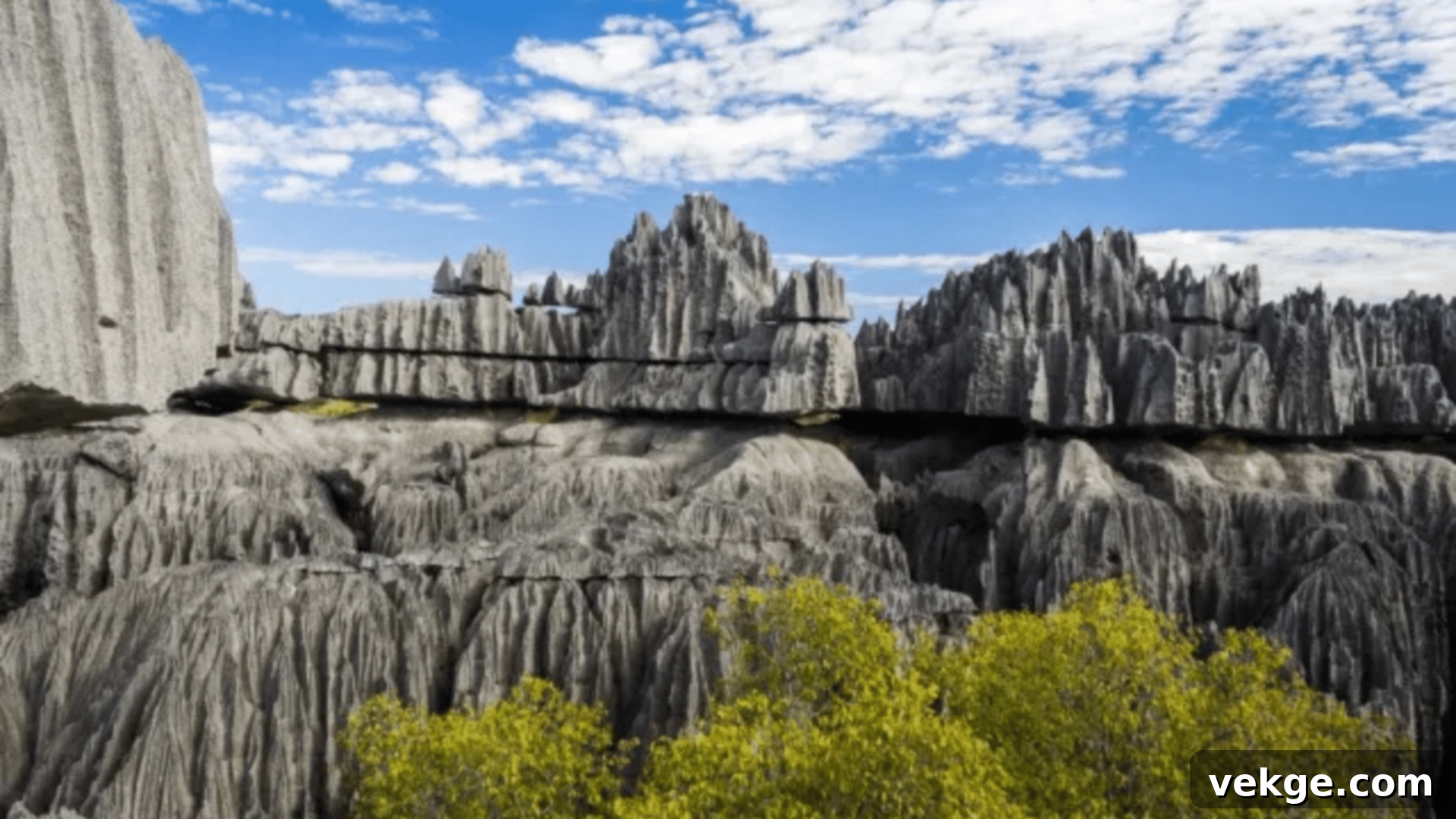
Overview: Tsingy de Bemaraha National Park is an extraordinary UNESCO World Heritage Site featuring a surreal ‘stone forest’ composed of thousands of razor-sharp limestone pinnacles. This otherworldly landscape, sculpted by millennia of erosion, creates a challenging yet immensely rewarding environment for exploration, often requiring visitors to navigate via fixed ropes, ladders, and suspension bridges. It’s a remarkable testament to nature’s incredible artistry and geological power.
- World Heritage Status: Designated a UNESCO World Heritage Site in 1990, recognizing its exceptional universal value, unique geological formations, and diverse ecosystems.
- Origin of Name: The term “Tsingy” translates to “where one cannot walk barefoot” or “to walk on tiptoes” in the Malagasy language, perfectly describing the sharp, pointed, and almost impassable nature of the terrain.
- Geological Marvel: Formed over millions of years by the relentless forces of tropical rain and wind cutting deep into colossal limestone plateaus, creating a complex labyrinth of canyons, caves, and towering spires.
Why Visit: Venture into one of the most unusual and dramatic landscapes on Earth, offering a truly unique adventure experience. Beyond the breathtaking geological spectacle, you’ll have the chance to spot unique wildlife, including several species of lemurs, birds, and reptiles that have remarkably adapted to this seemingly harsh environment. It’s an adventure that engages all the senses and presents a truly unique physical challenge.
Interesting Fact: Beneath the visible stone forest, there are extensive underground rivers, vast caves, and hidden grottos that further enhance the Tsingy’s mysterious and strange beauty, adding another layer of wonder to this natural masterpiece. These subterranean worlds host their own unique ecosystems.
3. Red Tsingy (Tsingy Rouge)
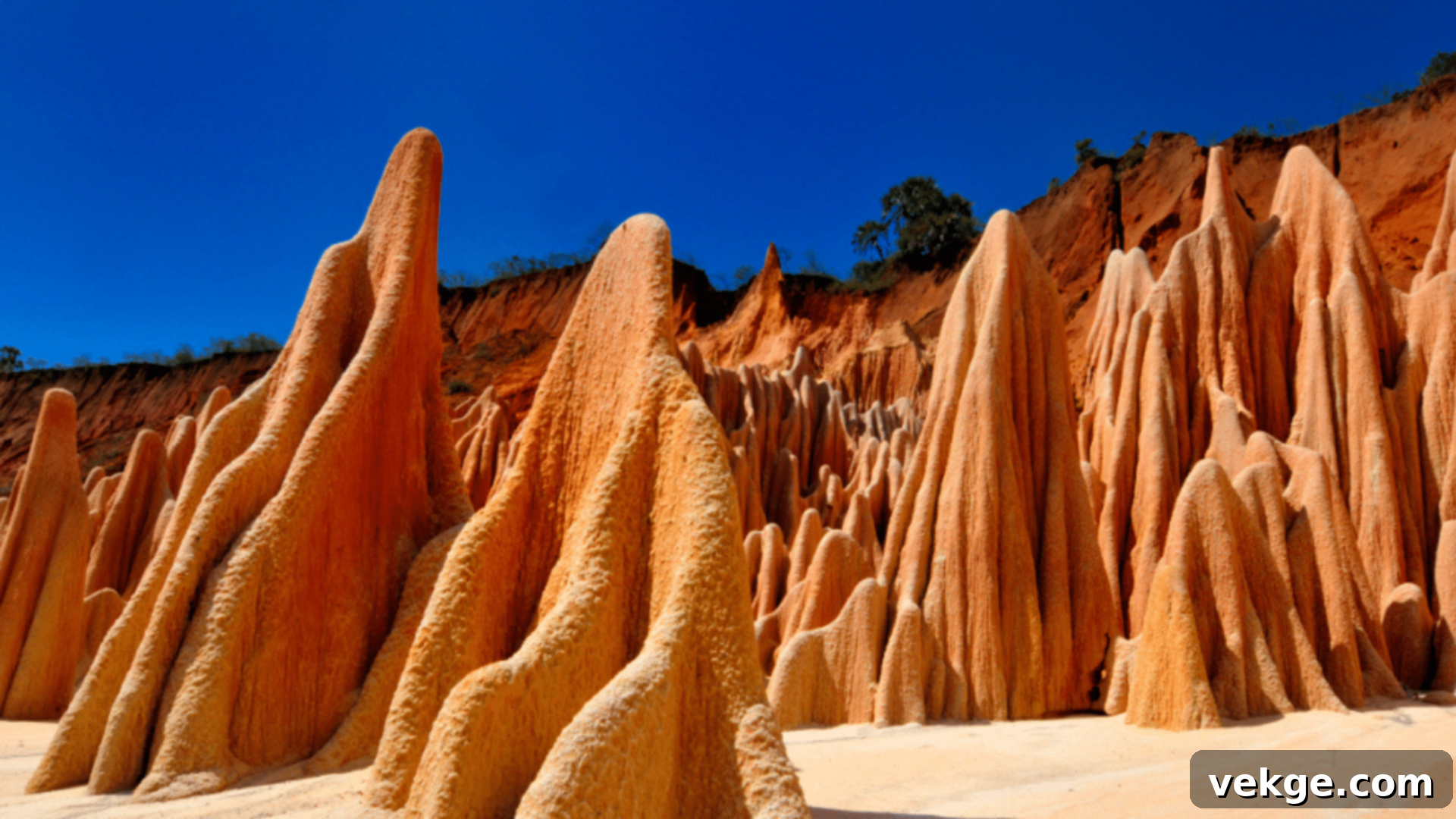
Overview: The Red Tsingy, or ‘Tsingy Rouge,’ presents a softer, more colorful, and equally stunning counterpart to the famed limestone Tsingy de Bemaraha. This distinct geological marvel is formed from delicate red laterite, an iron-rich clay, which has been eroded into intricate and fragile formations by wind and water. It offers a distinct visual experience, characterized by its warm, earthy hues that create a breathtaking panorama.
- Material Distinction: Unlike its grey limestone cousin, the Red Tsingy is primarily composed of lateritic clay, making its formations more delicate, easily eroded, and distinctly reddish.
- Vibrant Palette: Showcases a spectacular array of natural pink, red, and orange colors, which dramatically shift with the changing light throughout the day, creating a dynamic and incredibly photogenic dreamscape.
- Recent Formation: A relatively more recent geological formation, its rapid erosion is partly influenced by environmental factors such as deforestation and climate change, highlighting the fragility of natural landscapes.
Why Visit: While less harsh and challenging to navigate than the stone Tsingy, the Red Tsingy is equally beautiful and incredibly photogenic with its striking warm colors and intricate structures. It provides a stark and beautiful contrast to the limestone Tsingy, offering a different perspective on Madagascar’s geological diversity and the immense power of natural erosion. It’s an accessible natural wonder that mesmerizes with its vibrant hues.
Interesting Fact: The Red Tsingy is a much newer natural creation, having formed over a significantly shorter timescale compared to the millions of years it took for the stone Tsingy de Bemaraha to develop. This rapid formation and erosion make it both a fascinating geological site and a point of concern for environmentalists.
4. Amber Mountain National Park (Montagne d’Ambre)
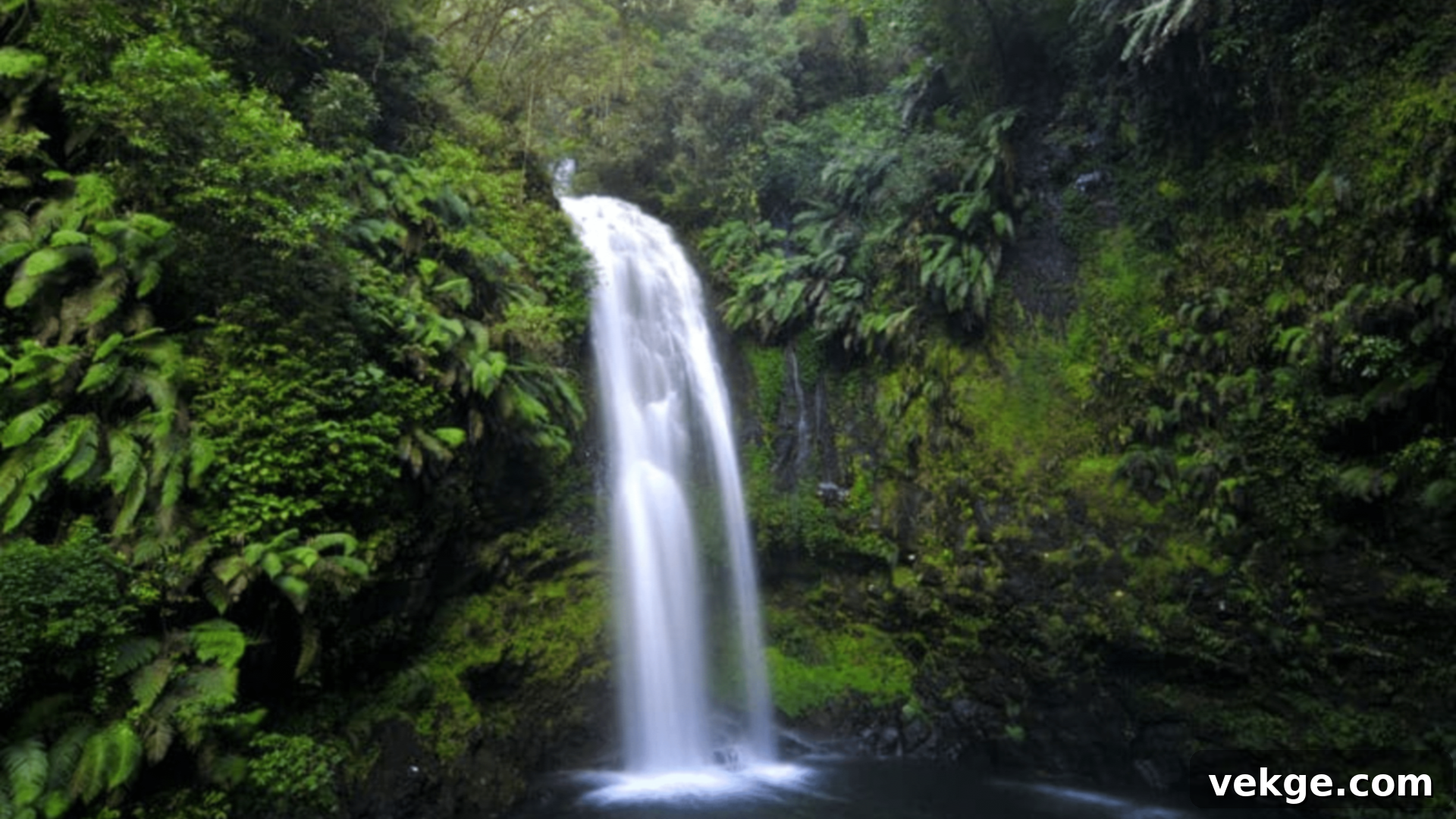
Overview: Amber Mountain National Park (Montagne d’Ambre), located in the north of Madagascar, is a lush, volcanic massif characterized by its misty peaks, cool microclimate, and dense tropical rainforests. This ecological haven is a stark contrast to the drier southern regions, offering a refreshing retreat into a world of unique biodiversity, stunning waterfalls, and serene crater lakes. It’s a critical sanctuary for a wide variety of endemic species, including several lemur species and countless chameleons.
- Ecological Sanctuary: Home to several sacred lakes and numerous beautiful, cascading waterfalls, providing critical habitats and a constant water supply for its rich wildlife.
- Biodiversity Hotspot: Teems with an incredible diversity of life, including vibrant orchids, lush ferns, numerous bat species, and countless colorful butterflies, alongside several species of lemurs unique to the region.
- Hiking Paradise: Offers a network of well-maintained hiking trails suitable for various fitness levels, leading visitors through enchanting forests to spectacular viewpoints and invigorating natural pools.
Why Visit: Immerse yourself in a magical rainforest setting, explore stunning crater lakes, and marvel at breathtaking waterfalls. Amber Mountain offers a tranquil escape and an exceptional opportunity for wildlife spotting, particularly for those interested in lemurs, chameleons, and birds in their pristine natural habitat. The cooler, misty climate provides a welcome respite from the tropical heat of other regions of Madagascar.
Interesting Fact: The mountain’s unique cool, misty climate creates an ecosystem that feels remarkably different from other parts of Madagascar, fostering a distinct array of plant and animal life. This isolated microclimate has allowed for the evolution of species found nowhere else, almost like a ‘lost world’ within the island.
5. Nosy Be and Nosy Iranja
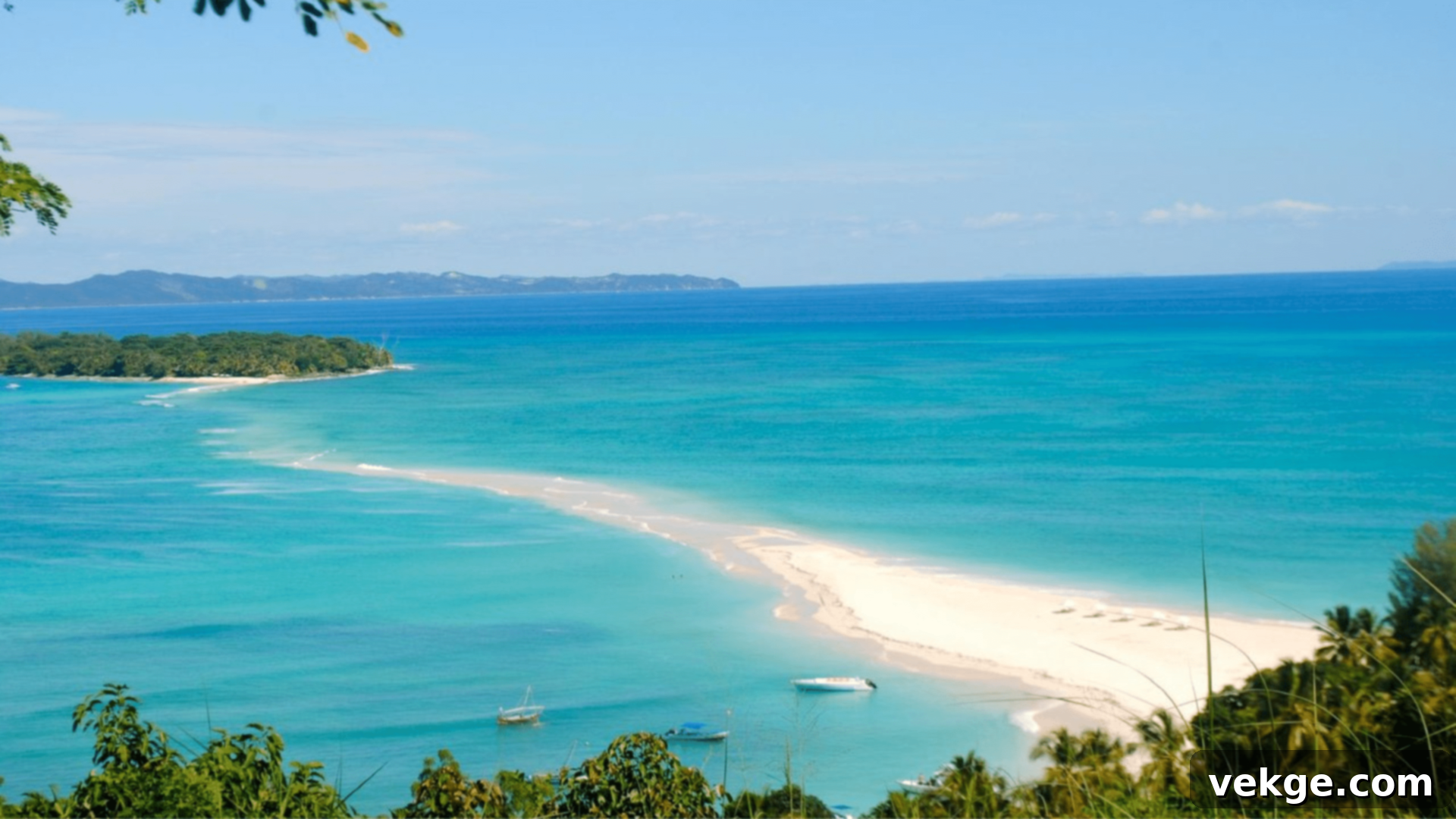
Overview: Off the northwest coast of Madagascar, the idyllic islands of Nosy Be and Nosy Iranja represent the epitome of tropical paradise. Nosy Be is the larger, more developed island, known for its vibrant atmosphere, exquisite beaches, and fragrant vanilla and ylang-ylang plantations. Nearby, the smaller, largely uninhabited Nosy Iranja is famed for its breathtaking beauty and a unique natural phenomenon: a narrow sandbar that spectacularly emerges at low tide, connecting two distinct islets.
- Dual Island Charm: Nosy Iranja, comprised of two islets (Nosy Iranja Be, inhabited by fishermen, and Nosy Iranja Kely, home to a lighthouse), is situated just south of the larger, more bustling Nosy Be, offering contrasting experiences.
- Miraculous Connection: At low tide, a stunningly beautiful white sandbar creates a natural walkway, allowing visitors to literally walk between the two islands, a truly magical and unforgettable experience often described as walking on water.
- Postcard Perfect: This iconic image of the pristine sandbar connecting two lush islands, surrounded by turquoise waters, is frequently used to showcase the unparalleled beauty of Madagascar’s pristine beaches and marine treasures.
Why Visit: Experience the sensation of walking on water as you traverse the stunning sandbar between these two tropical gems. Nosy Be offers a blend of vibrant culture, delicious seafood, and luxurious relaxation, while Nosy Iranja provides a more secluded, untouched paradise perfect for swimming, snorkeling, and sunbathing in absolute tranquility. It’s an ideal destination for beach lovers, water sports enthusiasts, and honeymooners alike.
Interesting Fact: The ephemeral nature of this natural walkway, appearing only during low tide, emphasizes the importance of planning your visit to fully experience this breathtaking phenomenon. It’s a magnificent testament to the ever-changing beauty and powerful influence of the ocean’s tides.
6. Piscine Naturelle at Isalo National Park
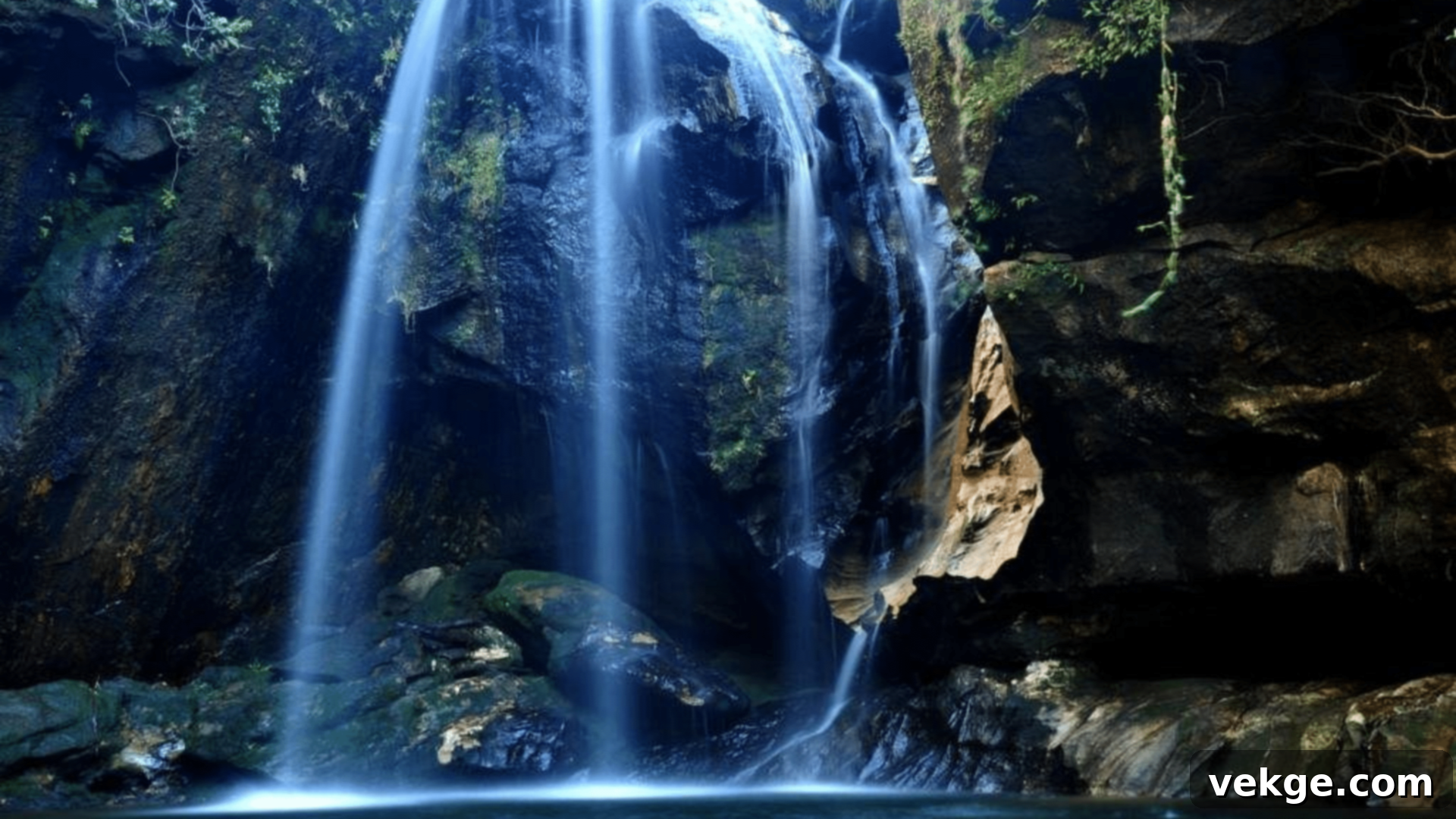
Overview: Nestled within the dramatic landscapes of Isalo National Park in southern Madagascar, the Piscine Naturelle (Natural Pool) is a serene and inviting oasis. This captivating natural swimming pool, fed by a refreshing waterfall, is set within a secluded sandstone canyon surrounded by lush tropical vegetation. It offers a welcome and invigorating respite for hikers exploring the park’s sun-baked sandstone formations and vast savannahs.
- Park Location: A major highlight within the vast and diverse Isalo National Park, renowned for its unique sandstone formations, deep canyons, sacred burial sites, and endemic flora and fauna.
- Lush Surroundings: Despite the often arid conditions of much of the park, the pool is encircled by vibrant, tropical trees, ferns, and mosses, creating a surprisingly cool, verdant, and shaded microclimate.
- Rewarding Hike: Reaching this tranquil spot involves a rewarding hike through sun-drenched canyons and across expansive plains, where you might encounter ring-tailed lemurs, Sifakas, and other fascinating wildlife.
Why Visit: After a strenuous and often hot hike through Isalo National Park’s stunning, rugged terrain, there’s no greater pleasure than taking a refreshing dip in this perfectly natural, emerald-green pool. It’s a truly invigorating experience that rejuvenates both body and spirit, making the journey well worth the effort and providing a picture-perfect memory.
Interesting Fact: The striking deep green and blue colors of the pool’s crystal-clear waters, contrasted beautifully with the surrounding red sandstone cliffs and lush greenery, create a picture-perfect spot and a favorite among visitors for its sheer beauty, tranquility, and natural charm.
7. Royal Hill of Ambohimanga

Overview: The Royal Hill of Ambohimanga, a UNESCO World Heritage Site, is a deeply sacred and historically significant place in Madagascar, located just outside the bustling capital, Antananarivo. This fortified royal settlement comprises a complex of royal residences, burial sites, and sacred places, offering panoramic views over the surrounding countryside. It stands as a powerful symbol of the Merina monarchy and the enduring cultural identity of the Malagasy people, preserving centuries of tradition.
- UNESCO Status: Inscribed as a UNESCO World Heritage Site in 2001, recognized for its exceptional testimony to the Malagasy civilization and its strong spiritual and cultural significance to the island’s population.
- Royal Heritage: Contains well-preserved examples of traditional Malagasy royal architecture, including the King’s Palace (Rova), the Queen’s Summer House, and various sacred enclosures, all protected by an ancient stone wall.
- Cultural Epicenter: Has been a site of pilgrimage, worship, and royal significance for the Merina people since the 16th century, maintaining its profound spiritual importance and cultural relevance to this day.
Why Visit: Immerse yourself in Madagascar’s rich royal history and profound cultural past. Exploring Ambohimanga offers a unique insight into the traditions, beliefs, and architectural styles of the Merina kingdom, providing a tangible link to the island’s pre-colonial era. The informative guided tours often bring the history and legends to life, making it a compelling educational and spiritual experience.
Interesting Fact: This revered hill was once the home and spiritual center for King Andrianampoinimerina (1787-1810), a pivotal figure who successfully united much of Madagascar under his rule, laying the foundations for the unified Kingdom of Madagascar. His legacy continues to resonate throughout the island’s history and culture.
8. Gare de Soarano (Old Train Station)
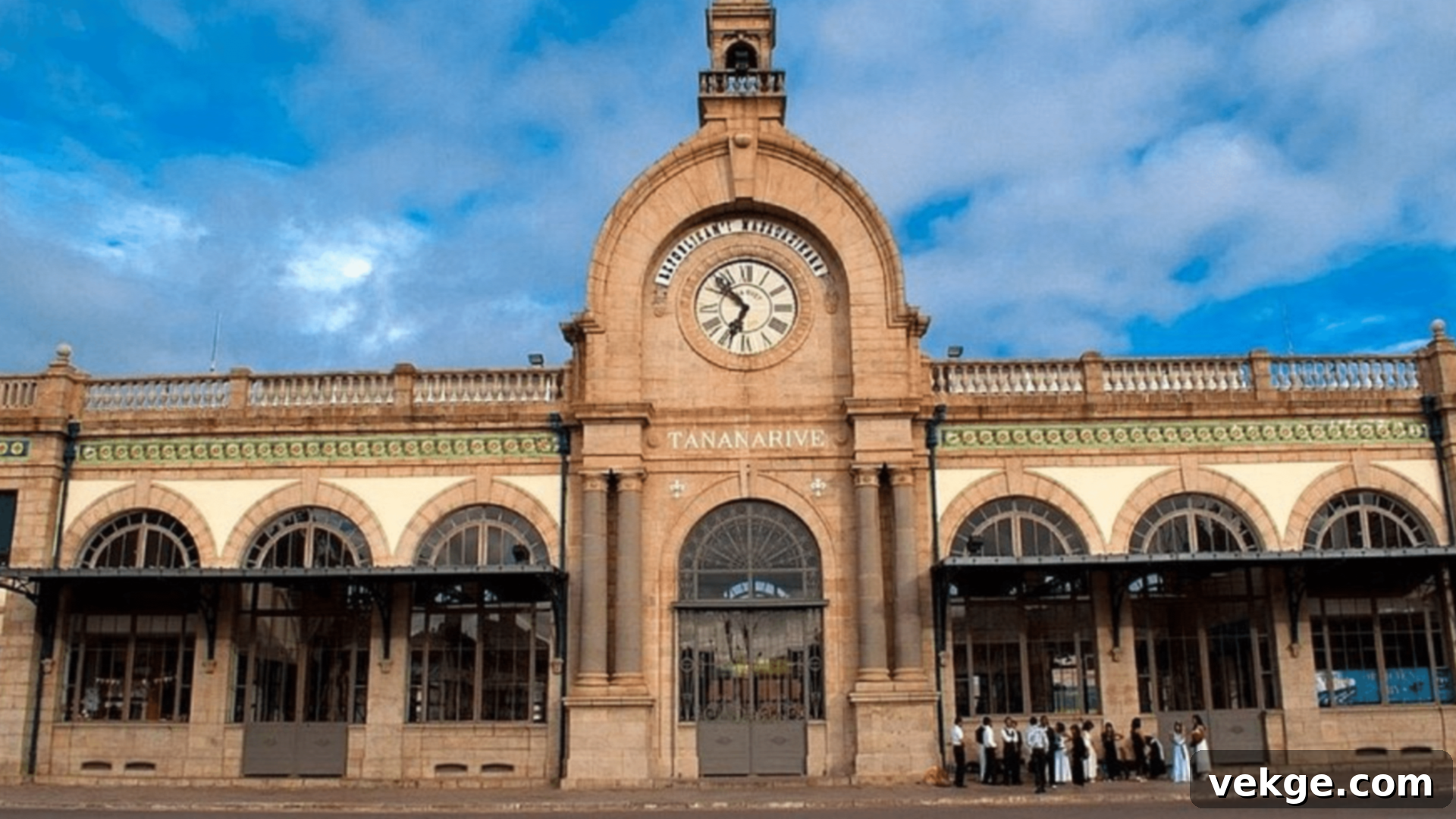
Overview: The Gare de Soarano, once the grand central train station of Antananarivo, has been beautifully transformed into a vibrant shopping mall and cultural hub. This impressive colonial-era building retains much of its original architectural grandeur and charm, offering a fascinating blend of history and modernity. It stands as a testament to Madagascar’s past infrastructural ambitions and its capacity for innovative urban renewal, drawing locals and tourists alike.
- Urban Landmark: Located prominently in the bustling capital city of Antananarivo, serving as a popular meeting point, commercial center, and a hub of activity.
- Unique Dining: Features a distinctive train-themed restaurant where diners can enjoy delicious Malagasy cuisine and drinks inside an actual old caboose, providing a nostalgic and memorable dining experience.
- Artistic Showcase: The interior walls and common areas are often adorned with a vibrant array of local Malagasy art and handicrafts, transforming the space into an impromptu gallery that celebrates local talent and culture.
Why Visit: Explore a remarkable example of how a historic building can be thoughtfully repurposed, given new life while meticulously preserving its original character and architectural charm. It’s an opportunity to appreciate colonial architecture, discover unique local crafts, and enjoy a one-of-a-kind dining experience within a piece of living history. It offers a fascinating glimpse into contemporary urban Malagasy life.
Interesting Fact: Visitors to the Gare de Soarano have the unique opportunity to dine and socialize within an authentic, beautifully restored train car, making it not just a meal but an immersive journey back in time to Madagascar’s railway golden age, blending gastronomy with history.
9. Spiny Forest (Didieraceae Forest)
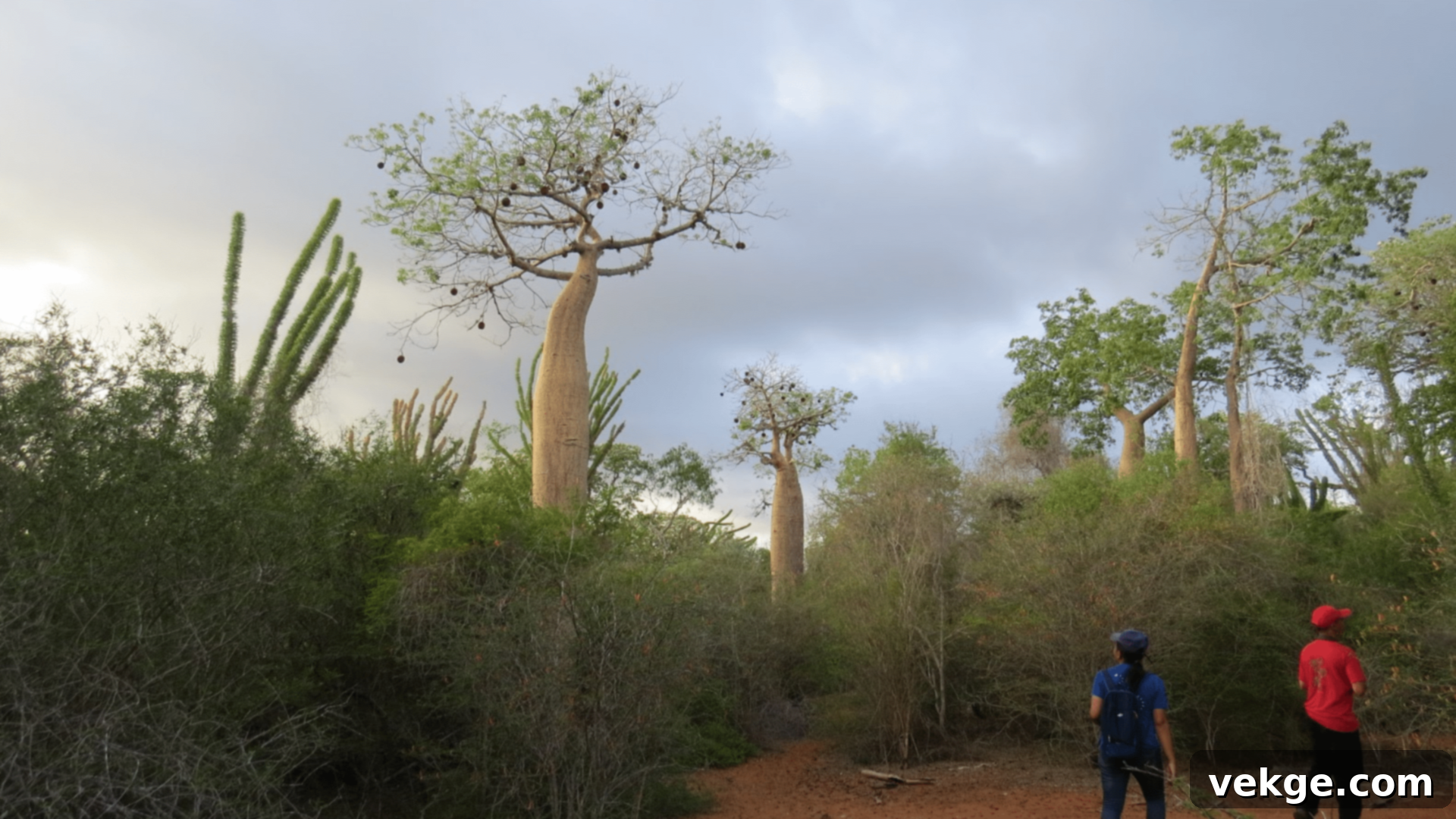
Overview: The Spiny Forest, located in the arid southwestern regions of Madagascar, is an utterly unique and biologically distinct landscape. This bizarre ecosystem is characterized by its remarkable collection of xerophytic plants, many of which are endemic to the island and are armored with spines to conserve precious water. Dominated by odd-shaped, succulent trees and shrubs like the ‘octopus tree’ (Didierea madagascariensis) and drought-adapted baobabs, it resembles a scene from a fantasy novel or an alien planet.
- Endemic Flora: Home to extraordinary spiny octopus trees, peculiar bottle-shaped baobabs, and other succulent plants that have evolved incredible adaptations to survive extreme drought conditions.
- Ecological Debate: Scientists often debate whether this unique biome should be classified as a true forest or a desert, given its specific climatic conditions and the highly specialized characteristics of its plant life.
- Unconventional Classification: Frequently referred to as a “thicket” or “bushland” because its unusual plant community doesn’t neatly fit into conventional ecological categories, highlighting its distinctiveness and singular evolutionary path.
Why Visit: Witness a plant community that exists nowhere else on Earth. The Spiny Forest offers an extraordinary opportunity to observe evolution in action and appreciate the remarkable resilience of life in extreme conditions. It’s a visually stunning and ecologically significant area that will undoubtedly challenge your perceptions of what a “forest” can truly be, providing an unforgettable experience for botanists and curious travelers alike.
Interesting Fact: The surreal and often cartoon-like appearance of the landscape, with its bizarrely shaped trees and spiny plants, often evokes comparisons to illustrations from a Dr. Seuss book, making it a truly whimsical, fantastical, and unforgettable natural attraction that seems to defy reality.
10. Anjanaharibe-Sud Special Reserve
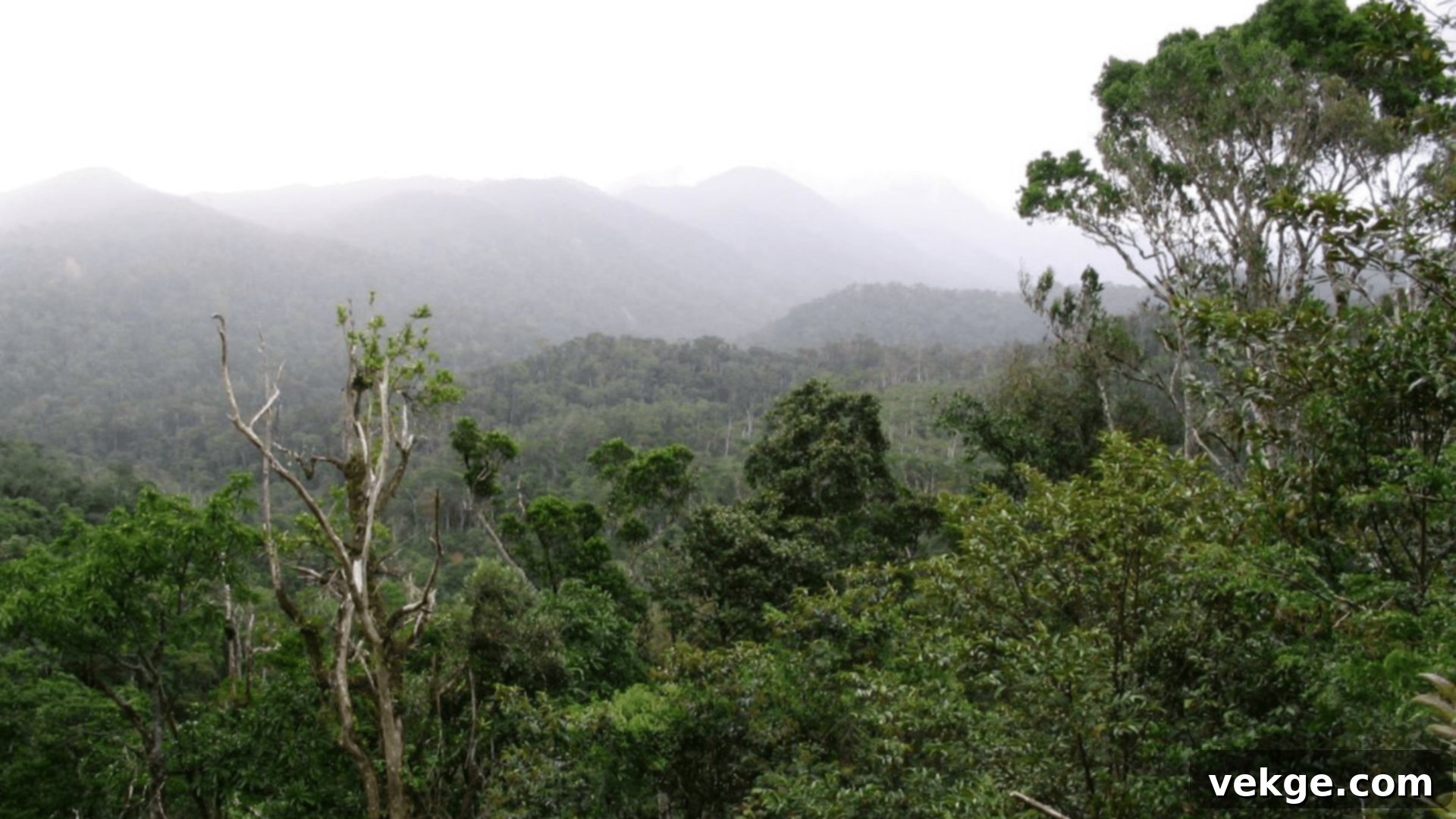
Overview: Anjanaharibe-Sud Special Reserve is a vital protected rainforest reserve located in the remote northeastern part of Madagascar. Characterized by steep, mist-covered mountains and pristine primary forests, it is a biodiversity stronghold and a critical habitat for numerous rare and endemic plant and animal species. Its relative remoteness ensures a truly wild and untouched experience for the adventurous explorer and conservationist.
- Ecological Corridor: This reserve forms an essential link to the renowned Marojejy National Park via the Betaolana forest corridor, creating a larger continuous protected area crucial for wildlife migration and genetic exchange.
- Rare Species Haven: A sanctuary for many exceptionally rare plant and animal species, including several critically endangered lemur species (like the Silky Sifaka), chameleons, and unique orchids, making it a high-priority conservation area.
- Rugged Beauty: Defined by its challenging terrain of steep, often mist-shrouded mountains and untouched primary rainforest, offering breathtaking natural beauty and challenging trekking opportunities for seasoned adventurers.
Why Visit: Explore some of Madagascar’s most pristine and untouched rainforests, providing an authentic wilderness experience far from the beaten path. It offers an exceptional opportunity to spot elusive wildlife in their natural, undisturbed habitat, making it a dream destination for serious naturalists, wildlife photographers, and trekkers seeking profound engagement with nature.
Interesting Fact: Anjanaharibe-Sud Special Reserve is currently on UNESCO’s tentative list, proposed as a possible extension to the existing “Rainforests of the Atsinanana” World Heritage Site. This underscores its significant ecological importance and potential for further global recognition and protection.
11. Rainforests of the Atsinanana
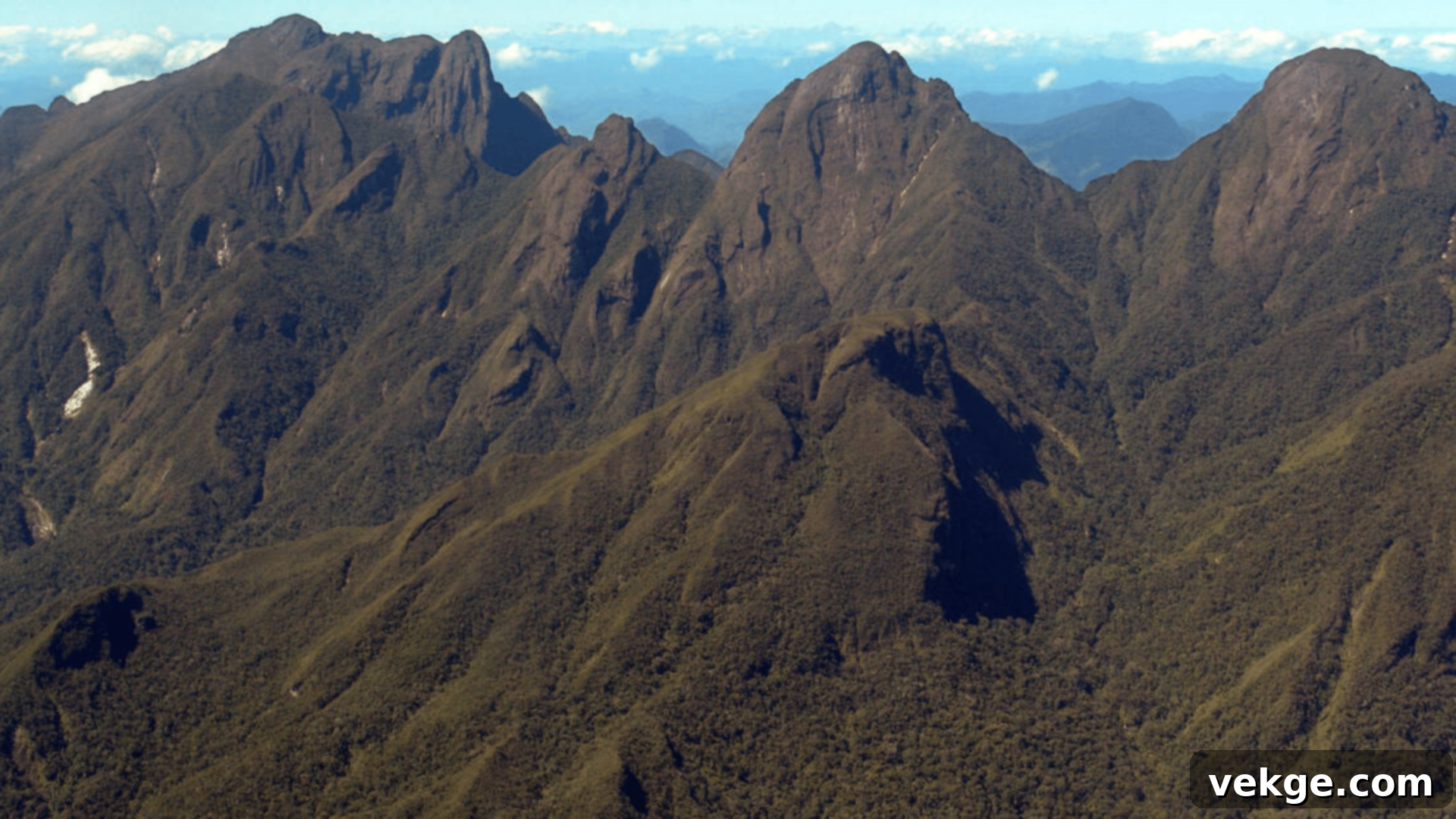
Overview: The Rainforests of the Atsinanana comprise a series of six national parks located along the eastern part of Madagascar. This collective UNESCO World Heritage Site is an extraordinary global biodiversity hotspot, protecting the island’s critically important eastern rainforests. These ancient forests are crucial for the ongoing ecological processes necessary for the survival of Madagascar’s unique endemic wildlife, especially its iconic lemurs, which are found nowhere else.
- Global Recognition: Designated a UNESCO World Heritage Site in 2007, recognizing its superlative natural phenomena and areas of exceptional natural beauty and aesthetic importance, as well as its ecological significance.
- Unmatched Endemism: Home to an astounding concentration of plants and animals found nowhere else on Earth, making it a prime example of evolutionary isolation and diversification on an unparalleled scale.
- Conservation Challenge: Currently listed on the “in danger” list by UNESCO due to persistent threats, primarily from illegal logging, bushmeat hunting, and other human pressures, highlighting the urgent need for robust conservation efforts.
Why Visit: Experience some of the most biologically diverse and unique forests in the world. A visit provides an incredible opportunity to encounter numerous species of lemurs, chameleons, frogs, and a vast array of endemic plant life in their natural, intricate ecosystems. It’s a profound journey into the very heart of Madagascar’s natural heritage and a powerful reminder of the planet’s irreplaceable biodiversity treasures.
Interesting Fact: These interconnected rainforests host an astonishing number of lemur species, many of which are critically endangered, along with other unique animals like the elusive fossa and various rare bird species, making them vital sanctuaries for Madagascar’s irreplaceable fauna and a global priority for conservation.
12. Ankarana Special Reserve
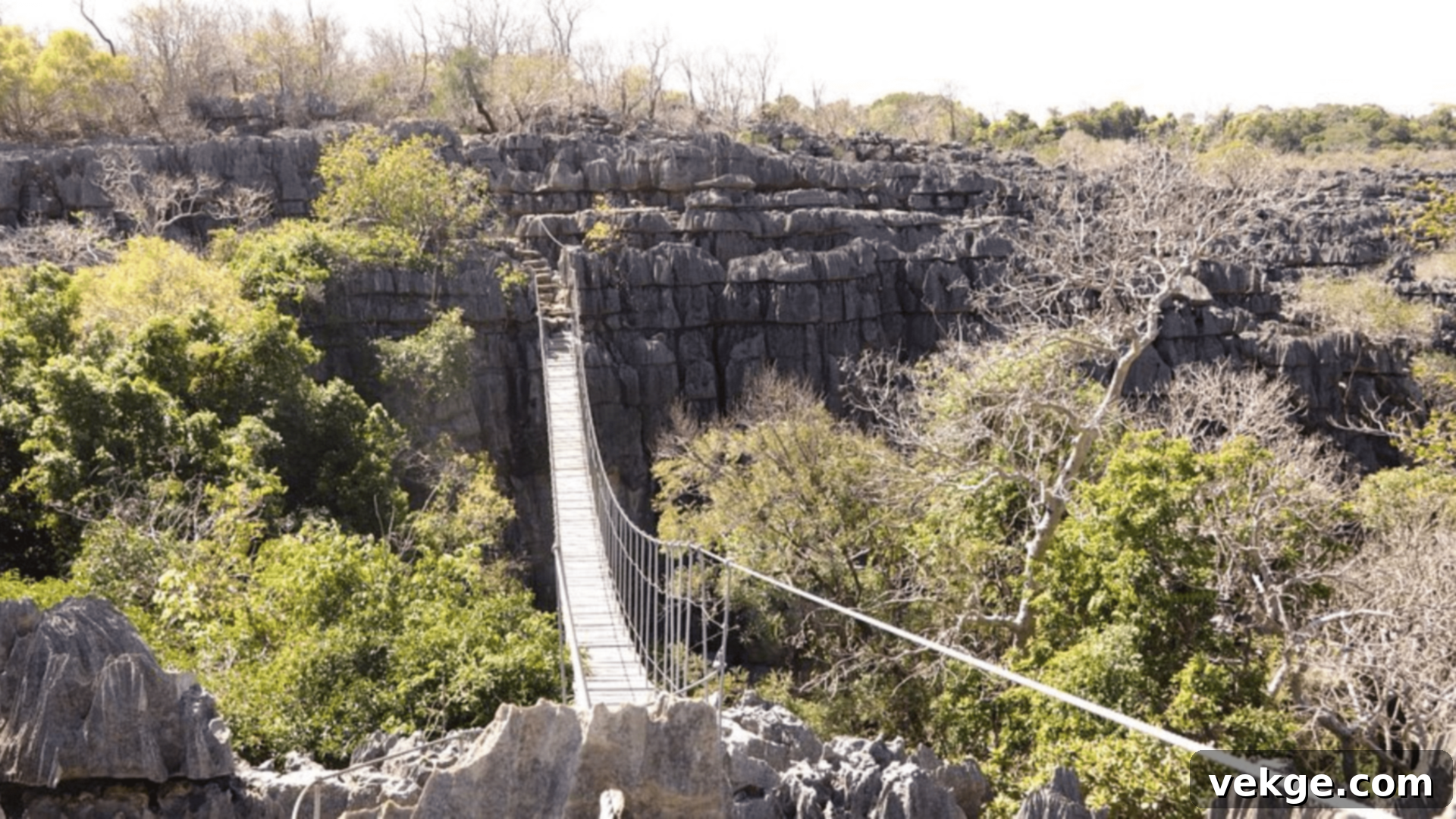
Overview: Ankarana Special Reserve, situated in northern Madagascar, is a captivating protected area renowned for its dramatic limestone ‘tsingy’ formations, extensive underground cave systems, and diverse dry deciduous forests. It’s a land of hidden rivers, ancient geological wonders, and a vibrant array of wildlife, offering adventurers a truly multi-faceted exploration experience both above and below ground, making it a unique destination.
- Ecological Network: Forms a crucial part of the Dry Forests of the Andrefana, an important ecological region in western Madagascar, contributing significantly to its unique biodiversity and species adaptations.
- Subterranean Wonders: Features an intricate network of underground rivers and vast cave systems, some of which are home to unique blind crocodiles and other fascinating cave-dwelling species adapted to the dark.
- Wildlife Richness: A haven for many kinds of wildlife, including several species of lemurs (such as crowned lemurs and Sanford’s brown lemurs), numerous bat species, and a wide variety of birds and reptiles.
Why Visit: Discover a thrilling combination of geological wonders and vibrant ecosystems. Ankarana allows you to explore the dramatic above-ground limestone spires and delve into mysterious underground caves. It’s an ideal destination for those seeking adventure, caving, unique wildlife encounters, and stunning landscapes in a single, remarkable protected area.
Interesting Fact: The reserve contains some of the largest and most complex cave systems in Africa, with some extending for over 100 kilometers. These subterranean worlds are not only geological marvels but also host unique troglobitic (cave-dwelling) species, making them scientifically invaluable and incredibly intriguing.
13. Tsimanampetsotse National Park
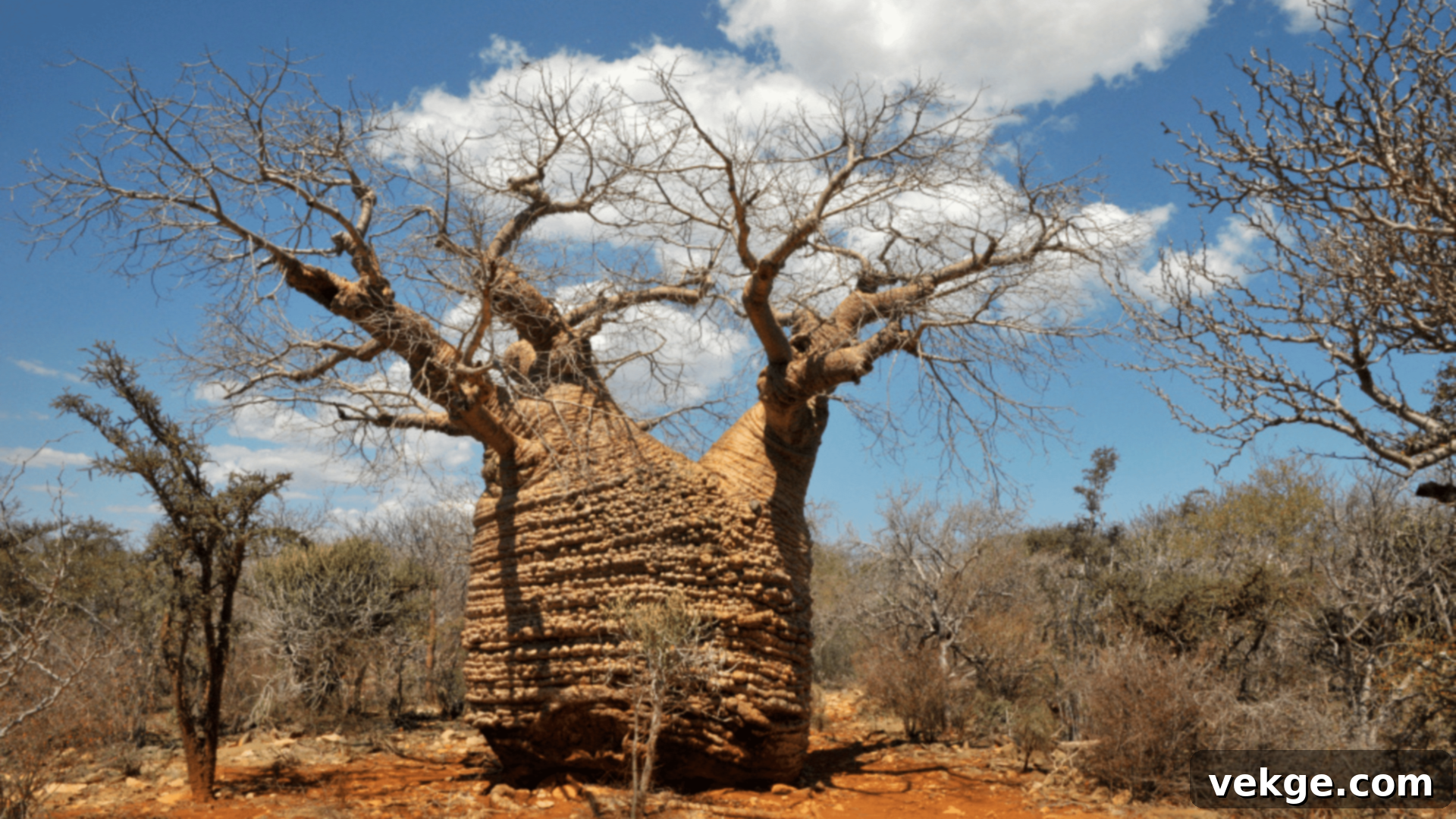
Overview: Tsimanampetsotse National Park, located on the arid southwestern coast of Madagascar, is a unique coastal park centered around a hypersaline (salt) lake and surrounded by a distinctive dry spiny forest. This Ramsar-designated wetland is a vital refuge for an incredible array of water birds and showcases a unique adaptation of life to extreme conditions, offering striking contrasts in its landscape and ecology.
- Regional Significance: Another integral component of the Dry Forests of the Andrefana, contributing to the region’s exceptional and highly adapted biodiversity, including rare plants and animals.
- Ephemeral Beauty: The park’s salt lake is famously known to occasionally turn a vibrant pink or red due to the presence of specific algae and microorganisms, creating a stunning and often surreal natural spectacle.
- Avian Haven: A critical habitat for thousands of flamingos (both greater and lesser), pelicans, and numerous other endemic and migratory water birds, making it a prime destination for dedicated birdwatchers and nature photographers.
Why Visit: Witness the dramatic contrast between the brilliant blue-white or sometimes vibrant pink lake and the parched, spiny landscape that surrounds it. It offers a unique opportunity to observe diverse birdlife, ancient baobab trees, and fascinating flora in a truly singular environment, providing a peaceful yet visually impactful experience that highlights nature’s adaptability.
Interesting Fact: Some of the majestic baobab trees found within Tsimanampetsotse National Park are estimated to be over 1,000 years old, standing as silent sentinels that have witnessed millennia of the park’s dynamic ecological history and the changing climate of Madagascar.
14. Mikea National Park
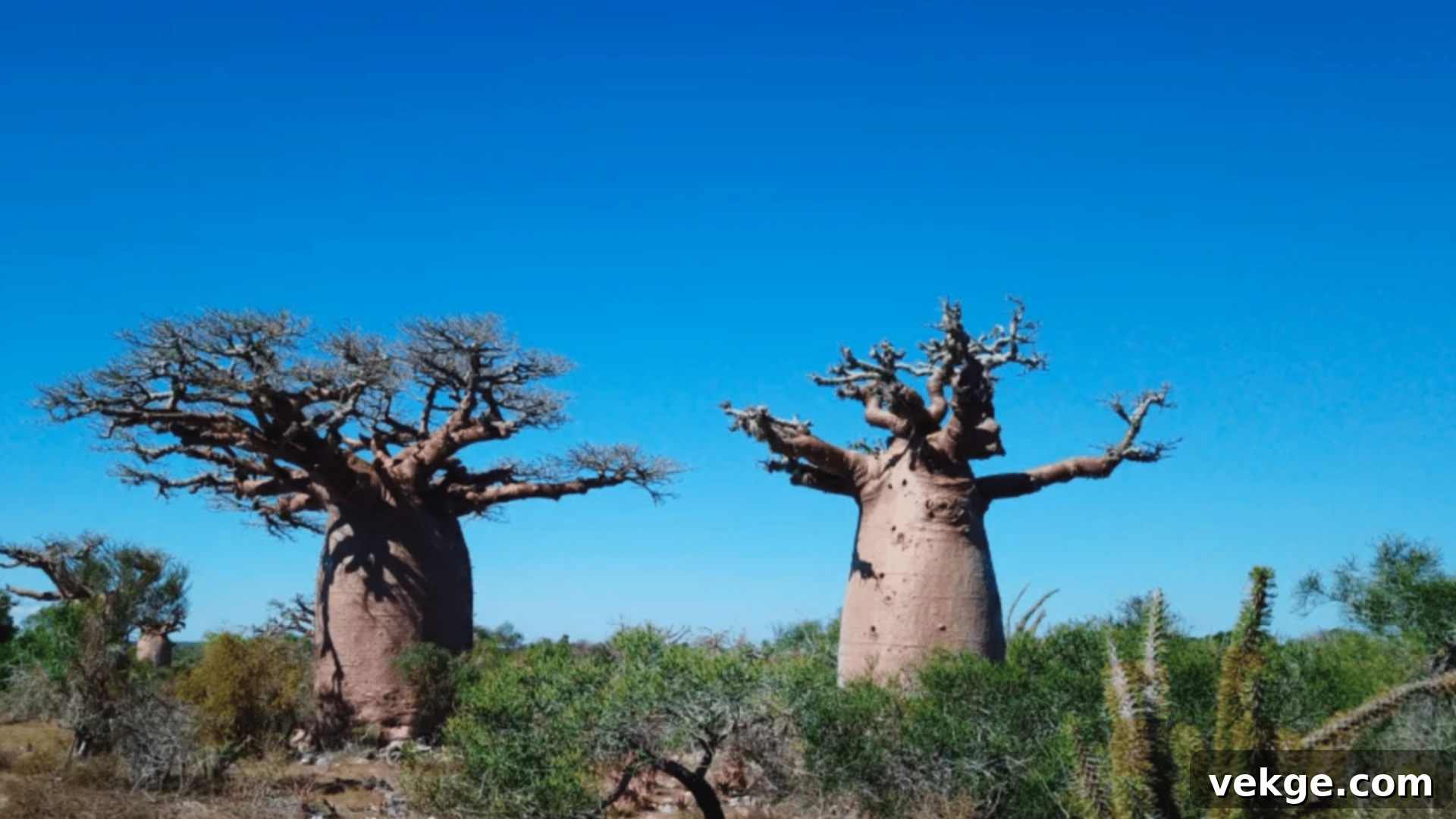
Overview: Mikea National Park, a relatively newer protected area in southwestern Madagascar, encompasses a remarkable range of ecosystems, from dense spiny forest and dry deciduous forest to pristine coastal areas and marine habitats. Named after the semi-nomadic Mikea people who traditionally inhabit this region, the park protects a unique blend of natural and cultural heritage, representing one of Madagascar’s most ecologically diverse and culturally significant landscapes.
- Ecological Diversity: As part of the Dry Forests of the Andrefana, it features a rich tapestry of habitats, including arid spiny forests, dry deciduous forests, mangrove areas, and beautiful, untouched beaches.
- Indigenous Heritage: Home to the enigmatic Mikea people, an indigenous group known for their traditional hunter-gatherer lifestyle and deep spiritual connection to the forest, offering a unique cultural dimension to the park experience.
- Varied Landscapes: Offers a stunning variety of environments, from the thorny thickets of the spiny forest to the serene expanses of its coastal and marine zones, providing a comprehensive look at Madagascar’s diverse ecosystems.
Why Visit: Experience an incredible cross-section of Madagascar’s unique ecosystems within a single protected area. Mikea National Park provides opportunities for challenging forest treks, rewarding birdwatching, and relaxing on pristine, often deserted beaches, along with a chance to learn about the traditional way of life of the Mikea people. It’s a profound journey into both natural and human adaptation.
Interesting Fact: The Mikea people have developed an extraordinary array of survival skills and traditional knowledge, allowing them to thrive in one of Madagascar’s most challenging and arid environments, relying heavily on forest resources and traditional hunting techniques passed down through generations.
15. Upper Town (Haute-Ville) of Antananarivo
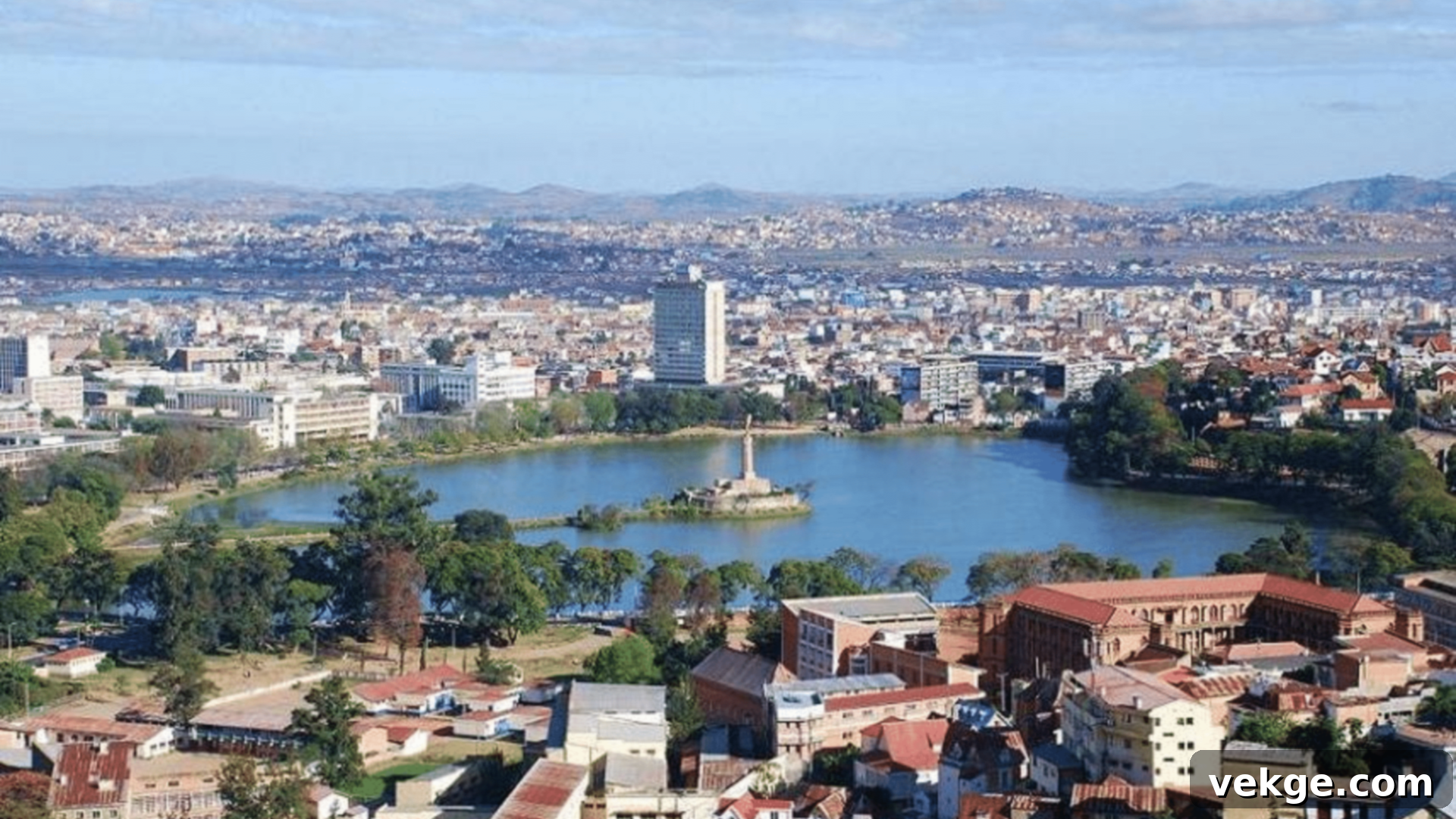
Overview: The Upper Town, or ‘Haute-Ville,’ of Antananarivo is the historic heart and cultural soul of Madagascar’s capital city. Perched atop one of the highest hills, it offers a fascinating journey through the island’s colonial and pre-colonial past, characterized by its winding cobblestone streets, grand royal palaces, ancient churches, and charming traditional Malagasy houses. This vibrant district provides a panoramic vista of the bustling city below and is deeply steeped in history, tradition, and local life.
- Architectural Fusion: Showcases a distinctive blend of traditional Malagasy architecture, characterized by multi-storied brick houses with carved wooden balconies, beautifully juxtaposed with elegant French colonial buildings.
- Panoramic Vistas: Strategically situated on one of the city’s highest points, offering breathtaking panoramic views across Antananarivo, especially stunning at sunset when the city lights begin to twinkle.
- Heritage Recognition: Currently on UNESCO’s tentative list for World Heritage status, acknowledging its unique urban fabric, historical significance, cultural value, and the preservation of traditional Malagasy urbanism.
Why Visit: Delve into the rich urban culture and profound history of Madagascar by exploring the Upper Town’s charming streets and significant landmarks. It’s an opportunity to visit historic palaces, sacred sites, and experience the lively atmosphere of local markets and artisan workshops, gaining a deep appreciation for the capital’s unique heritage and the Malagasy way of life. It’s a compelling walk through centuries of history and a vibrant cultural immersion.
Interesting Fact: The Upper Town’s ingenious urban design masterfully integrates with the natural hilly landscape, creating a one-of-a-kind city layout. This intricate adaptation to the terrain, with its terraced houses and winding paths, results in an architectural and urban planning marvel rarely found elsewhere in Africa or indeed, the world, reflecting Malagasy ingenuity.
How to Make the Most of Your Madagascan Adventure: Essential Travel Tips
To ensure an enriching and unforgettable experience while exploring Madagascar’s incredible landmarks, thoughtful preparation and a flexible mindset are key. The island’s diverse terrain, varying climates, and unique cultural nuances require specific considerations to maximize your enjoyment and comfort. Embracing a spirit of adventure, cultural sensitivity, and responsible tourism will also greatly enhance your journey.
- Pack Smart and Light: Bring sturdy, comfortable walking shoes or hiking boots, as many of Madagascar’s natural sites involve significant trekking over uneven terrain. Given the island’s often unpredictable weather, pack layers including lightweight sun protection (hat, sunscreen), insect repellent, and essential rain gear. Quick-drying clothing is highly recommended.
- Hire a Local, Certified Guide: To truly appreciate the natural wonders and spot elusive wildlife, it is highly recommended, and often mandatory in national parks, to explore with a local, certified guide. Their expertise in the local ecosystem, profound knowledge of animal behaviors, and invaluable cultural insights will significantly enrich your visit.
- Embrace Local Culture and Language: Learning a few basic Malagasy phrases, such as “Salama” (hello), “Misaotra” (thank you), and “Veloma” (goodbye), can open doors to warmer interactions with local people and show genuine respect for their culture and traditions.
- Prioritize Health and Safety: Consult your doctor about necessary vaccinations and recommended anti-malarial medication well before your trip. Pack a comprehensive first-aid kit with any personal prescription medicines. Be prepared for varying living conditions in remote areas, which may include limited access to amenities and medical facilities.
- Practice Responsible Tourism: Adopt eco-tourism principles by minimizing your environmental footprint, adhering strictly to park rules, and supporting local businesses and communities. Avoid disturbing wildlife, maintain a respectful distance, and under no circumstances purchase products made from endangered species.
- Understand Transportation Realities: Be aware that travel within Madagascar can be slow and challenging due to varying road conditions and infrastructure. Allow ample time for transit between destinations, and consider hiring a reputable local driver or tour operator for reliability, safety, and logistical ease.
- Currency and Connectivity: The local currency is the Malagasy Ariary (MGA). While major towns might have ATMs, it’s advisable to carry a sufficient amount of cash, especially when visiting remote areas. Internet and mobile connectivity can be limited outside of major cities, so prepare to disconnect and fully immerse yourself in the experience.
- Hydration and Food Safety: Always drink bottled or purified water. Be cautious with street food and ensure all food is freshly cooked and served hot to avoid stomach upsets.
Conclusion: A Journey to the Heart of Madagascar’s Uniqueness
Madagascar is unequivocally a destination like no other, offering some of the most unique and awe-inspiring landmarks in the world. From the majestic, centuries-old baobab trees that stand as sentinels of time to the surreal, razor-sharp formations of the Tsingy, and the verdant embrace of its lush rainforests, these places vividly demonstrate why Madagascar is rightly celebrated as a global natural wonder. Each site is a vital chapter in the island’s grand narrative, showcasing its extraordinary evolutionary history, unparalleled biodiversity, and the resilient spirit of its people.
Visiting these iconic sites provides more than just scenic beauty; it offers a profound journey into understanding Madagascar’s unparalleled biodiversity and its rich cultural tapestry. These landscapes and cultural monuments are living museums, each telling a distinct part of the story of this amazing island and its long, isolated history. They serve as powerful reminders of the planet’s incredible diversity, the fragility of unique ecosystems, and the urgent need for global conservation efforts to protect such precious environments.
Your journey through Madagascar’s landmarks will undoubtedly foster a deeper appreciation for this island’s remarkable distinctiveness, setting it apart from anywhere else on Earth. These breathtaking natural and cultural treasures are not merely beautiful; they are irreplaceable components of our global heritage that demand our respect, protection, and boundless wonder. Embark on this adventure, and let Madagascar transform your perspective on the natural world, leaving you with memories that will last a lifetime.
We invite you to share your thoughts, personal experiences, and any additional tips for exploring Madagascar’s wonders in the comments section below! Your insights could help fellow travelers plan their extraordinary Madagascan adventure.
